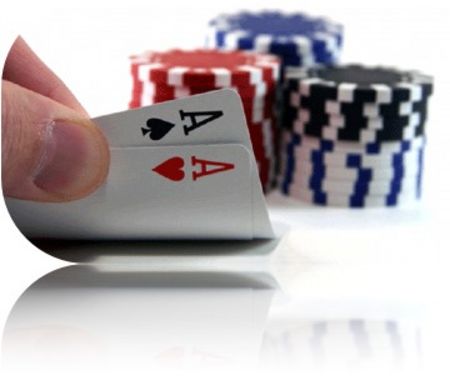Dangerous Flops

Almost never draw to overcards with flop types of a high pair, three-suited, three-
connected, or all high cards. The exception of course is when you have a flush or
straight draw also; however, be careful drawing with an all-high card flop since the
only value of your hand is probably the straight draw.
For example, when you hold AK and the flop is QJ9, your hand is especially
vulnerable. The ace or king could easily give someone two pair or a straight, so
you’re only out may be the gut-shot ten, especially against several opponents.
Two-Suited
When the flop is two-suited, you may only be drawing to four outs if an opponent
has a flush draw. This draw has the same odds as a gut-shot draw, except your
draw is only to a pair and you have (he risk of running into a flush on the river.
If one of your overcards is one of the two suits on the flop, this increases the value
of your hand a little. For example, if you have the K ♣ Q ♠ and the flop is T ♥ 6 ♣ 4 ♣,
all three of your outs to a king are good. You would have five outs in this case, the
three kings and two queens, in addition to your backdoor flush draw.
These draws however are still very weak. You should almost always be folding with
a two-suited flop. The only times you might consider calling is when the pot is
exceptionally large or you are only against one or two opponents with a large pot
and the risk of a flush draw is not very high.
Two-Connected
When there are two connected high cards, you should usually fold against several
opponents unless you have a straight draw also. With several opponents, there is a
good chance you are against a set, two pair, or that your outs are counterfeited if
they have straights or two pair draws. Against one or two opponents, you might play
if there is a large pot. If the connected cards are low, you do not need to worry so
much about the straights, unless your opponents played out of the blinds or from
late position.
Three of a Kind
Three of a kind flops are sometimes playable since an opponent will most likely
need a pocket pair to have a decent hand. This is the one type of flop where
holding an ace overcard is advantageous compared to a king or queen since you
could possibly win with ace high. Tend to fold these hands against a preflop raiser
since the likelihood of a pocket pair is higher.
Low Pair
The number and position of your opponents is important when playing overcards to
a flop with a low pair. If you are playing against the blinds or against many
opponents, you should probably fold with a low pair on the flop; however, you could
possibly play against one or two opponents depending on the situation. For
example, two early players are unlikely to be playing low cards.
Rainbow with One High Card
You can sometimes play a rainbow flop with only one high card under the right
conditions. The problem with these flops is that your out could give an. opponent
two pair since your opponents usually play high cards. For example, if the flop is
T65, the most likely hands of your opponents are AT, KT, QT, JT, and finally T9. If
you hold KQ, your hand is vulnerable to an opponent holding KT or QT, This does
not mean that you should always fold, but you need to discount your outs for this
possibility.
Sometimes you can pin down your opponents on more specific hands. For
example, if a solid player playing out of early position comes out betting on this flop,
he probably does not hold KT or QT since most strong players do not play these
hands from early position. ATs or JTs are more likely; therefore, you should be
reluctant to play overcards in this situation unless you have specifically KQ.
Advanced Concept: Be careful when playing overcards when one of your overcards is exactly one
card above the highest card. Many opponents like to play connected cards, so your out could he
counterfeited.
Rainbow of All Rags
The best type of flop for overcard draws is a rainbow flop of all rags. Of course,
against many opponents you still have to worry about two pair and straights, but
against just a few this risk is reduced. Again, be careful with an ace overcard, as
many opponents will play Ax and your out could be counterfeited.
Betting Strategies
Whenever the conditions are right to play your hand, you need to decide what
betting strategies you will use. Realize however, that most of the time you should
be folding.
Semi-bluffing against three or more opponents generally is not profitable; therefore,
your general strategy in these cases is to check, and call if the conditions are right.
There are limes when you might bet from late position if everyone checks, hoping
for a free card on the turn. This strategy generally depends on the risk of a check-
raise. You can also try raising for a free card, bun you are paying a high cost for a
relatively weak draw. This play works best when you were the preflop raiser and the
conditions are just right, such as a large pot against a few opponents with a
favorable flop. Be careful in trying this play against aggressive opponents who will
sometimes reraise their top pair.
Against one or two opponents, there is always the possibility that the flop has not
helped anyone, so you can sometimes semi-bluff by either betting or raising. This is
especially true if you were the preflop raiser. Betting after a preflop raise is usually
justified, because your opponents will sometimes fold and you still have outs if they
call. Ace high might even be the best hand.
A semi-bluff raise however is more risky since an opponent has already indicated
strength. On the other hand, sometimes you can get strong players to fold middle or
bottom pair, or even top pair with weak kickers. When they do call, you still have
your overcard outs and possibly the chance for a free card on the turn.
Knowing when a semi-bluff has a decent chance at success takes time and
experience. You need to look at the betting sequences preflop, the position of your
opponents, the type of opponent, and the type of flop, to help determine the
possible holdings of your opponents and the chances that a bluff will he successful.
NEXT...Review

